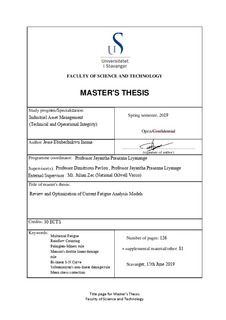| dc.contributor.advisor | Pavlou, Dimitrious | |
| dc.contributor.advisor | Liyanage, Jayantha | |
| dc.contributor.advisor | Zec, Julian | |
| dc.contributor.author | Inoma, Jesse | |
| dc.date.accessioned | 2019-10-09T07:13:50Z | |
| dc.date.available | 2019-10-09T07:13:50Z | |
| dc.date.issued | 2019-06-13 | |
| dc.identifier.uri | http://hdl.handle.net/11250/2621053 | |
| dc.description | Master's thesis in Offshore Technology : Industrial Asset Management | nb_NO |
| dc.description.abstract | The offshore oil and gas industry have been exposed to major challenges over the last decade, particularly demanding cost cuts and more effective technical solutions. Predictive systems and remaining life assessments for both machine and structural components are known to be one of the core areas that has gathered much attention lately. This thesis focuses on multiaxial fatigue that is a problem in a number of engineering structures and equipment. The ability to properly assess and quantify multiaxial fatigue of offshore equipment and structures has major benefits for owners of engineering assets both in terms of technical safety and integrity. Traditionally, Palmgren-Miner’s damage rule is used for life estimation involving multiaxial fatigue due to its ease of use. There are however some known shortcomings with Palmgren-Miner’s rule namely: it does not take into account the loading sequences. This for instance can result in overestimation of fatigue life in scenarios where stress amplitudes are decreasing, and moreover underestimation of fatigue life in scenarios where stress amplitudes increase.
This research work thus involves closely studying the application of Palmgren-Miner’s linear damage rule, Manson’s double linear damage rule, and Subramanyan’s non-linear damage rule for the purpose of enhancing the predictability of damage as well as accuracy of fatigue life assessments. Each of these techniques were applied on tie-rods of an offshore drilling top-drive having a known stress history. The loading histories were provided by a drilling company. The torque and axial force values are transformed to stress components for the corresponding critical spots. The “rainflow” counting technique is applied to the obtained stress histories and the mean stress effect is considered for the damage accumulation calculations. The fatigue life prediction of the three models are justified and discussed.
This research work is aimed at contributing towards the utilization of more robust fatigue life estimation techniques such as Manson’s double linear damage rule and simplified non-linear damage rules which capture the true nature of the fatigue that equipment’s are subjected to, and thus to improve the reliability of the fatigue life predictions. | nb_NO |
| dc.language.iso | eng | nb_NO |
| dc.publisher | University of Stavanger, Norway | nb_NO |
| dc.relation.ispartofseries | Masteroppgave/UIS-TN-IMBM/2019; | |
| dc.rights | Navngivelse 4.0 Internasjonal | * |
| dc.rights.uri | http://creativecommons.org/licenses/by/4.0/deed.no | * |
| dc.subject | offshore teknologi | nb_NO |
| dc.subject | driftsledelse | nb_NO |
| dc.subject | industrial asset management | nb_NO |
| dc.subject | multiaxial fatigue | nb_NO |
| dc.subject | olje- og gassnæringen | nb_NO |
| dc.subject | olje- og gassindustrien | nb_NO |
| dc.title | Review and Optimization of Current Fatigue Analysis Models | nb_NO |
| dc.type | Master thesis | nb_NO |
| dc.subject.nsi | VDP::Technology: 500::Marine technology: 580::Offshore technology: 581 | nb_NO |

